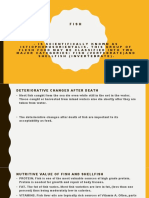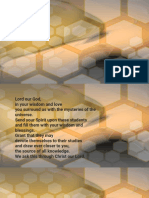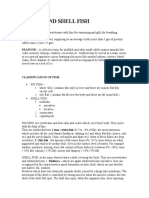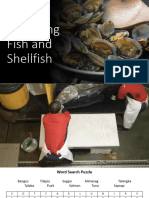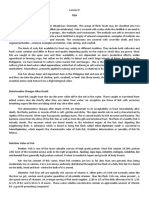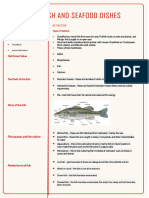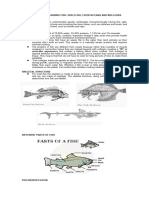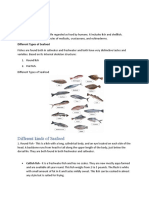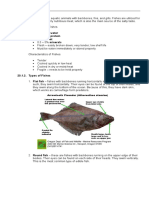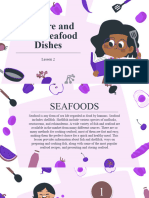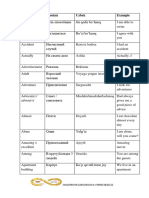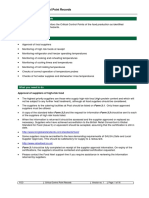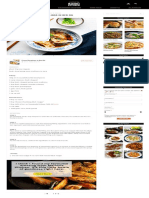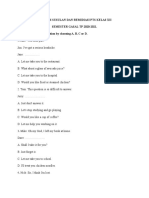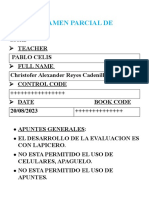Fish and Shellfish CLASSIFICATION OF FISH ON THE BASIS OF
THEIR FAT CONTENT:
FISH LEAN FISH
• These are the cold-blooded animals that have • have less than 2% fat in their edible flesh; while
backbones, an internal skeleton of cartilage and flesh-fish fat content is normally found in the liver.
bones, gills for breathing, and fins for swimming. • Examples: catfish, grouper, red snapper, swordfish,
• It is an excellent source of protein, and it is skate fish and tilapia.
interchangeable with meat in both quantity and
quality. MEDIUM FAT FISH
• Fish is rich in fat and provides energy for • have from 2 to 5% fat, white-fleshed fish, fat content
phosphorous but low in iron and in calcium. is normally found in the liver.
• Examples: rainbow trout and bluefish
COMPOSITION OF FISH
FAT FISH
• With more than 5% fat in the edible flesh, the flesh is
usually highly pigmented (yellow, pink, or grayish)
than that of the low-fat varieties.
• Examples: mackerel, eel, sardines and salmon.
CLASSIFICATION OF FISH BASED ON
SKELETAL TYPE:
FLAT FISH
• Fish have a backbone running horizontally through
TYPES OF FISH the center of the fish. They swim horizontally and
- Alumahan (Long-Jawed Mackerel) have both eyes on the top of their heads. EX. sole,
- Bisugo (Threadfin Bream) flounder, halibut, pompano, quitang.
- Salay-Salay/ Salaybutang/ Apahay
(Yellowtail Scad) ROUND FISH
- Galunggong (Mackarel Scad) • Round fish have a backbone on the upper edge of
- Salmon (Threadfin Salmon Fish) their bodies, they have an eye on each side of their
- Bangus (Milk Fish) heads, and they swim vertically. EX. trout, cod, tuna,
- Kitang (Spotted Scat) sea bass, grouper, salmon, mackerel. etc.
- Maya-Maya (RedSnapper)
- Tulingan/ Tambakol (Mackarel Tuna) BONELESS FISH
- Sapsap (Ponyfish/Slipmouth) • Fish with skeletons made of cartilage rather than
- Hiwas/ Tahas (Mene Moonfish) bones, their flesh usually contains no bones. Ex.
- Lapu-Lapu (Grouper) sharks, rays, skates and chimaeras.
- Salmonete (Striped Red Mullet)
- Tawilis (Sardinella tawilis) FISH SOURCES AND PRODUCTION:
- "Yellow-Fin" (Big eye tuna) • Marine Fish - are those fish obtained from salt
- Dalagang Bukid (Yellowtail fusilier) water (ex. apahap, lapu-lapu, tambakol, maya-maya,
etc.).
• Inland Fish - are those fish obtained from lakes,
MAJOR CLASSIFICATIONS ponds, rivers, and other inland bodies of water (ex.
OF FISH: bangus, tilapia, hito, bulig or dalag, etc.).
• Fin Fish (Vertebrate) • Mariculture - the act of culturing fish in salt water. It
- covered with scales, and have backbone. is applied to tahong and oysters.
• Shellfish (Invertebrate) • Aquaculture - the act of culturing fish in inland
- covered with some type of shell, and have soft water. Bangus has been cultured in pens in Laguna
unsegmented bodies. lake.
� 2. Fish requires less cooking time for it has no
MARKET FORMS OF FINFISH: connective tissues. It is fully cooked when it can be
• Live Fish. These are fishes which can be marketed easily flaked and eyeballs come out.
alive because they live long after catch. 3. Fat fish is best cooked by dry heat, broiled or
• Whole or Round Fish. This is the form in which baked.
most fresh fish is distributed in local market fish stalls. 4. Cooking should be done in the shortest possible
• Drawn Fish. This is a whole fish with only the time to avoid loss of moisture, flavor, and nutritive
entrails removed. value.
• Dressed Fish. This is the fish which has been 5. Because fish has mild flavor, it is frequently served
scaled and eviscerated. with sauce and some garnishes. Garnishes and
• Fillets. These are the two meaty sides of the fish cut sauce adds appearance and flavor to fish.
lengthwise away from the backbone. 6. Fish should be served soon after it has been
• Deboned. This is the form most convenient in the prepared, otherwise it will become dry and lose some
case of bangus, where the bones of the fish are of its flavor.
removed. 7. Fish may be fried at moderate heat until golden
• Steaks. These are the cross section slices of brown. Fry only a single layer at a time and dry it on
dressed fish which are relatively of large size, e.g. absorbent paper.
tanigue, and tambakol. 8. When baking fish, baste the fish occasionally to
• Sticks. These are fillets or steaks, cut further into prevent it from drying.
portion in uniform width and length like sticks hence
the name.
• Flaked. Fish meat separated from the whole fish is SHELLFISH
called flaked fish. STRUCTURE OF SHELLFISH
• As the name suggests, shellfish are animals that
dwell in water and have a shell or shell-like exterior.
(a) Whole or round: completely intact, as • No bone: Hard shells cover their bodies
caught. • Two types: mollusks and crustaceans
(b) Drawn: viscera removed. • Composed of water, vitamins, minerals, protein, and
(c) Dressed: viscera, scales, head, tail and fins fat.
removed.
(d) Steaks: cross-section slices, each container CRUSTACEANS
a section of backbone • As the name suggests, these have crusts on top or a
(e) Fillet: boneless sides of fish, with skin on or shell, which act as an armour.
off. • Shellfish have a pigment called 'astaxanthin', which
(f) Sticks: cross section of fillets. on contact with heat turns into a coral red colour,
which is much desirable for shellfish. Unlike fish,
shellfish do not have any cuts associated with them.
PRESERVATION OF FINFISHES: • Ex. Crabs, crawfish, scampis, lobster,
• Drying. This consists simply of sun drying the whole prawns/shrimps.
fish or butterfly filleted fish.
• Smoking. Smoking is another preservation method MOLLUSCS
of fish but its shelf-life is only a few days at room • Molluscs are shellfish that have a hard inedible shell.
temperature since the fish is not extensively dried. They are classified into three other
Smoked fish are locally called tinapa. subgroups-gastropods or univalves, bivalves, and
• Freezing. This does not improve the quality of fish cephalopods.
but preserves only as nearly as possible the quality 1. Gastropods -These molluscs have a single shell.
the fish in freezing. They are also known as univalves.
• Canning. Canned fish are kept at room temperature Ex. Abalones, snails, conches and whelks.
and have shelf life of several years. 2. Bivalves -These shellfish are covered by two
shells or valves. Ex. Clams, cockles, mussels, oysters
1. If fish is not to be cooked at once, it should be and scallops.
dressed and wrapped completely and place in freezer, 3. Cephalopods - Cephalopod means shellfish that
in a closedor a package. have legs over their heads.










